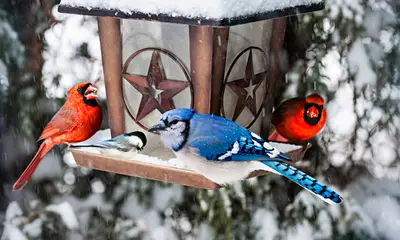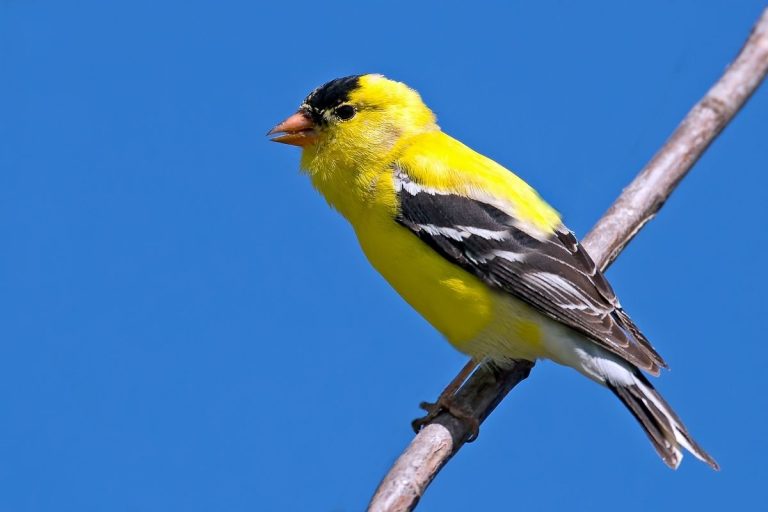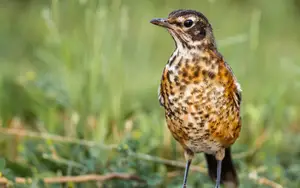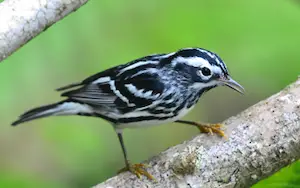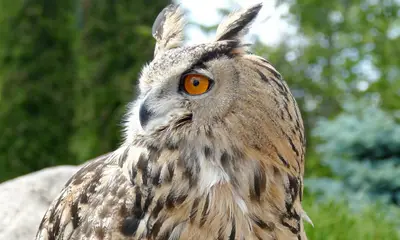31 Types Of SMALL Birds In North Carolina (ID Guide With Photos)
Did you recently come across a small bird in North Carolina, and want to know what species it was?
Identifying small backyard birds in North Carolina is not as easy as it might seem, since there are many bird species in the Old North state that are on the small side.
To help you identify the bird you saw, we’ll cover the most common small birds of North Carolina in this article.

What are the small birds of North Carolina?
The 31 types of small birds commonly found in North Carolina are:
- Carolina Wren
- Ruby-throated Hummingbird
- House Wren
- Yellow-rumped Warbler
- Eastern Phoebe
- Painted Bunting
- Blue-gray Gnatcatcher
- Palm Warbler
- Gray Catbird
- Tufted Titmouse
- Great Crested Flycatcher
- Northern Parula
- Tree Swallow
- Barn Swallow
- White-eyed Vireo
- Black-and-white Warbler
- Yellow-throated Warbler
- Cerulean Warbler
- Ruby-crowned Kinglet
- Downy Woodpecker
- Eastern Towhee
- Carolina Chickadee
- Common Yellowthroat
- Summer Tanager
- Eastern Bluebird
- Common Starling
- House Finch
- Red-winged Blackbird
- Indigo bunting
- Northern Cardinal
While many of these birds are found year-round in North Carolina, others only occur in the state during the nesting season in summer.
Yet other species are winter visitors in North Carolina, and some are vagrants that only rarely occur in the state.
Now let’s dive into the details, and take a closer look at each of these bird species in order to get the full scoop:
Carolina Wren
Scientific name: Thryothorus ludovicianus

The Carolina Wren is a widespread little garden bird with chestnut brown upperparts and creamy white underparts. Wings and tails have dark brown barring.
Males and females look alike, as do young individuals. The Carolina Wren is a non-migratory species, and can be spotted all year round in the state of North Carolina.
It is a familiar small bird, which can be found in backyards, scrubland, and forests. It feeds mostly on insects and other small invertebrates.
Ruby-throated Hummingbird
Scientific name: Archilochus colubris
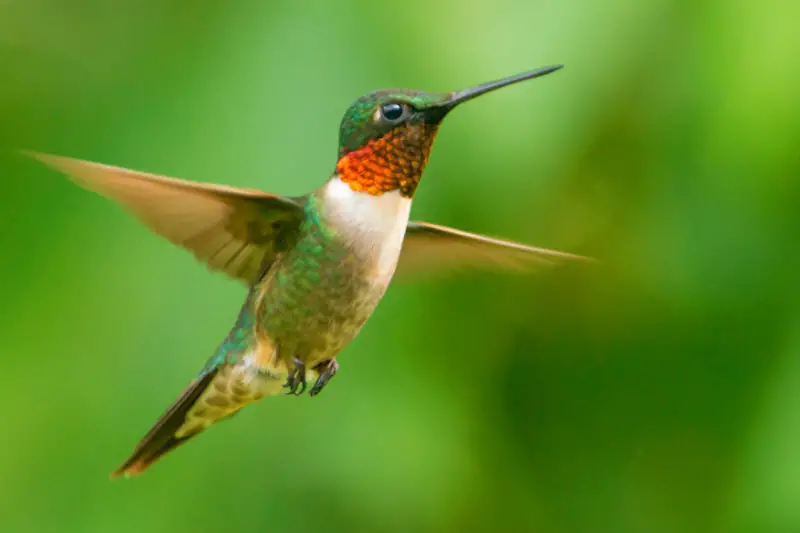
The Ruby-throated Hummingbird is the smallest bird in North Carolina. Weighing just 0.1 ounces, it is truly a tiny songbird compared to other species.
The male has a black throat that reflects flashes of ruby red when it catches the sunlight.
Similar to other Hummingbirds, it can fly straight up, down, or backwards, and can also hover in mid air, with its wings generating a humming sound like a tiny generator.
Hummingbirds are fascinating creatures that breathe up to 250 times per minute and have a heartbeat of over 1,200 times per minute.
The Ruby-throated Hummingbird is attracted to gardens and backyards that have tubular flowers that produce a lot of nectar.
In addition to flower nectar, it also feeds on insects. It is a long-distance migrant, and spends its winter in Central America.
House Wren
Scientific name: Troglodytes aedon
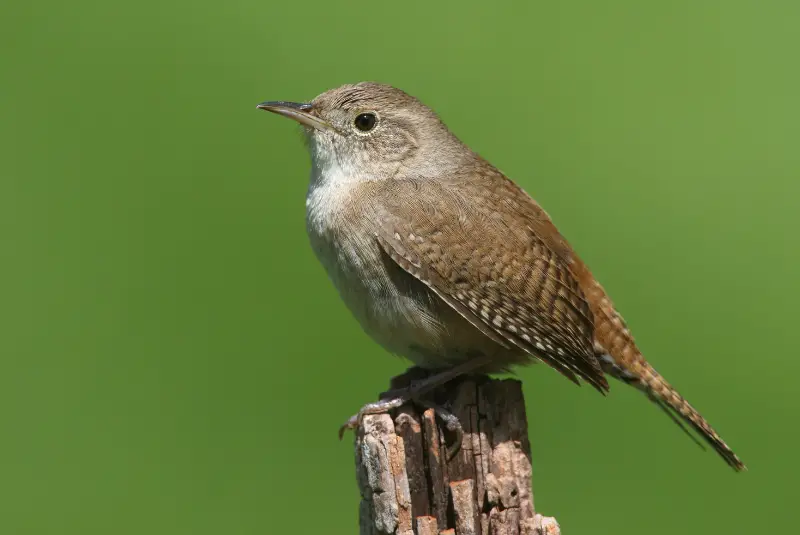
House Wrens are small songbird with relatively long beaks. Compared to other wrens, it has a long tail, which it likes to cock up.
At a distance, House Wrens resemble uniformly brown birds, but when viewed close up, you can discern subtle barring on their wings and tail.
In contrast to the Carolina Wren, which is a year-round resident in North Carolina, the House Wren is a winter visitor in North Carolina, where it winters from September through April.
Yellow-rumped Warbler
Scientific name: Setophaga coronata

While the sexes of the Yellow-rumped Warbler are dissimilar, they both have a yellow rump.
This warbler exists in several variations, and the eastern population that can be found in North Carolina are also called “Myrtle Warblers”.
These small warblers have blueish-gray upperparts with dark streaks, as well as a yellow rump and yellow flanks.
The Yellow-rumped Warbler is a winter visitor in North Carolina, where it can be seen from August through April.
Eastern Phoebe
Scientific name: Sayornis phoebe

The Eastern Phoebe is a plump small flycatcher with mostly gray colored plumage. The wings are slightly darker with blackish primarie and two light gray wing bars.
Both sexes, as well as juveniles, look very similar and have buff white underparts. It hunts flying insects from a perch, and catches them in flight.
It is a winter visitor in North Carolina that can be seen wintering in parks, backyards and woodlands from September to March.
Painted Bunting
Scientific name: Passerina ciris
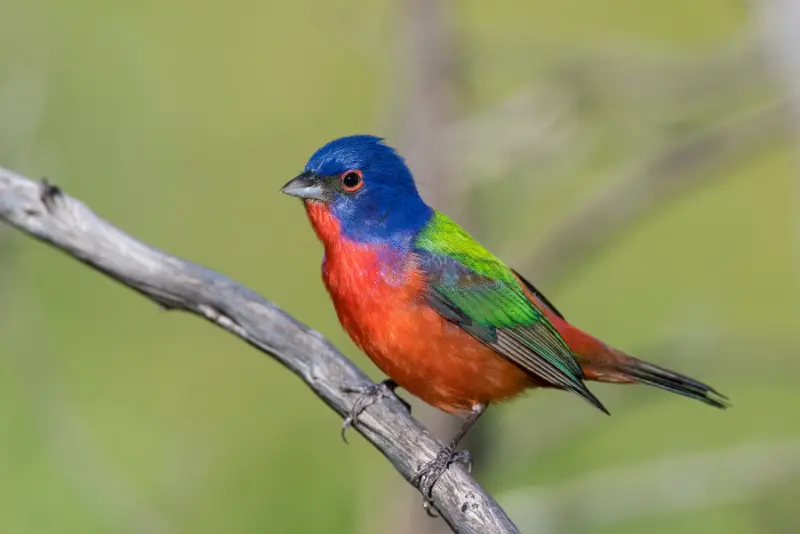
The Painted Bunting is a beautiful small songbird with a very colorful plumage.
Adult males have a bright red chest, throat, belly, and rump, contrasting with a dark blue hood. Their backs and the wings are yellowish green.
Females and immatures are pale green on top, with buff yellow underparts.
During the months of May through September, the Painted Bunting may be seen breeding in the southeastern part of the state.
This small bird is migratory, with most individuals wintering in Central America, except for a few individuals that spend the winter in southern North Carolina.
The secretive nature of the Painted Bunting makes it hard to observe when you’re bird watching, notwithstanding the bright colors of the male.
Its preferred habitat are clearings and margins of dense forests in areas close to water.
Similar to other buntings, it feeds mostly on seeds, except for the breeding season, when insects form an important part of its diet.
Blue-gray Gnatcatcher
Scientific name: Polioptila caerulea
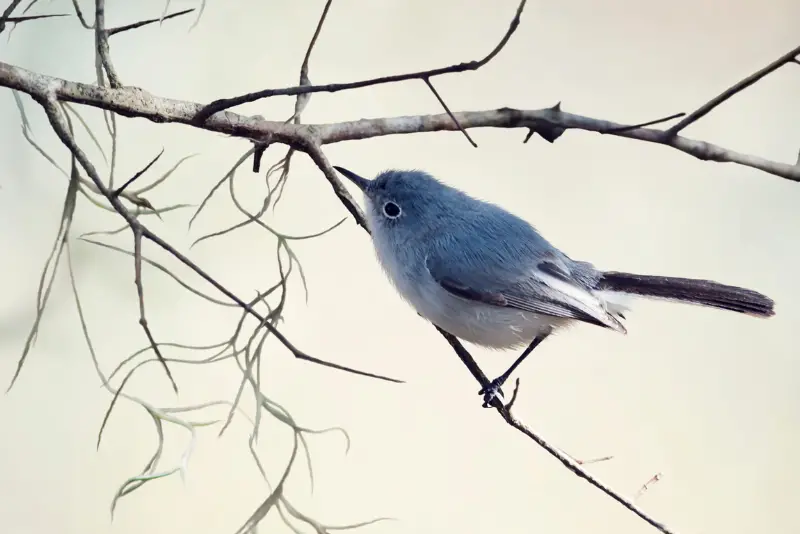
Except for its long tail, the Blue-gray Gnatcatcher looks a lot like a warbler.
The upperparts of adult males are blue-gray, while their underparts are a lighter gray. The black tail has white stripes at its margins.
Adult females and immatures are grayish on top, and light gray underparts. The eye of both sexes has a white eyering.
The Blue-gray Gnatcatcher may be encountered as a breeding bird in the temperate regions of North America, predominantly from early May through August.
It is a partial migrant, with southeastern populations being year-round residents. Northern populations, however, spend the winter in the southern USA and Central America.
A great way to identify this small bird is by its long tail that is often pointed upwards.
Palm Warbler
Scientific name: Setophaga palmarum
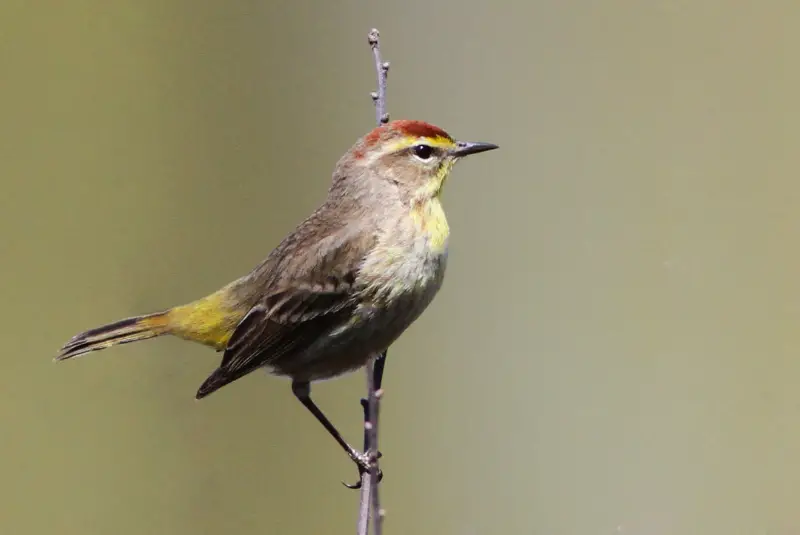
Both sexes of the Palm Warbler are quite similar to one another, with the exception that males tend to have a little more vibrant coloration than females.
The upperparts of adults are olive-brown and subtly striped, while the wings are darker overall with two light wingbars.
A great feature for identifying these small birds is their yellow throat and yellow supercilium (eyebrow stripe). The underparts are also mostly yellow with brown streaks.
The Palm Warbler breeds in the northern parts of North America, and winters in North Carolina from September through April.
Gray Catbird
Scientific name: Dumetella carolinensis
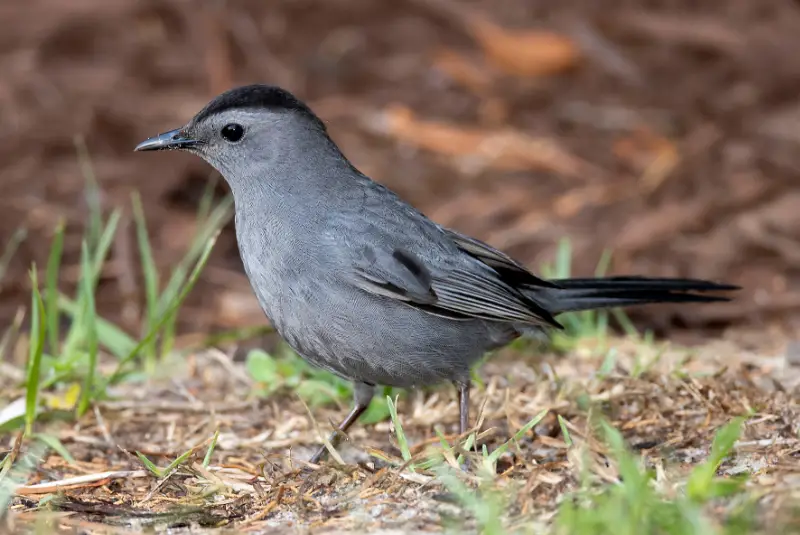
The Gray Catbird is easily recognizable due to its long tail. Both sexes and juveniles look alike and have dark gray body coloration, a black cap and a rufous red undertail.
The Gray Catbird is a common breeding bird in North Carolina, but its numbers further increase during the cold season, due to large numbers of migratory catbirds that winter in the Old North state.
They like to forage for insects and berries on the ground, and can be found in forests and scrubland.
They are secretive small birds that are hard to observe.
Tufted Titmouse
Scientific name: Baeolophus bicolor
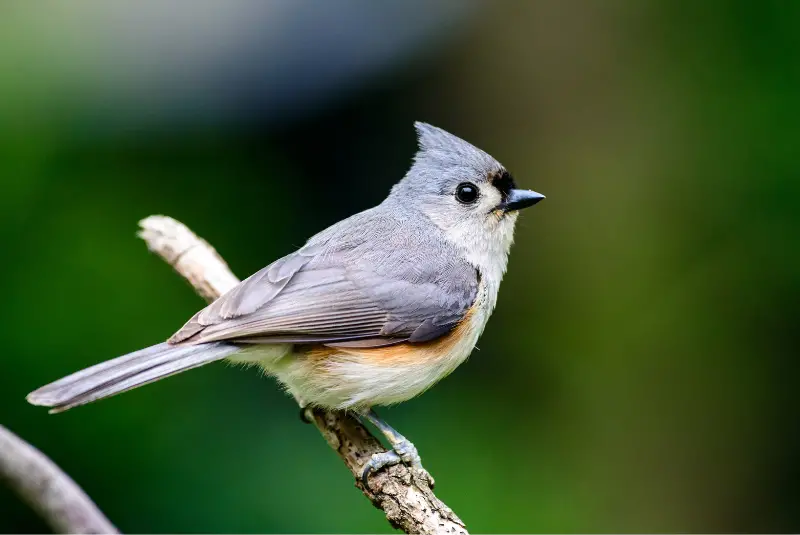
The Tufted Titmouse is a common and easily recognizable small songbird thanks to the distinctive crest on its head.
The sexes resemble each other, and have grayish-blue upperparts with a black forehead and a crest on the back of their head. The underparts are pale gray, but the flanks are tinged with buff orange.
It is a year-round resident throughout North Carolina, and is readily observed, since it isn’t very shy. It is a regular visitor at backyard feeders, and also breeds in nestboxes.
It prefers deciduous forests, as well as parks and backyards, where it feeds on small invertebrates and seeds.
Great Crested Flycatcher
Scientific name: Myiarchus crinitus

The Great Crested Flycatcher is a slim, long-bodied flycatcher. Adults have a dark brown head and back, as well as reddish brown wings and yellowish underparts.
The tail is rufous orange, and the crest of this bird is relatively small, and not very useful as a distinguishing feature.
The Great Crested Flycatcher is a regular sight in North Carolina during the summer, and it can be seen in the state from April through September.
It nests in a wide variety of woodland habitats, and feeds on insects as well as berries. Its winter range extends from Central to South America.
Northern Parula
Scientific name: Setophaga americana
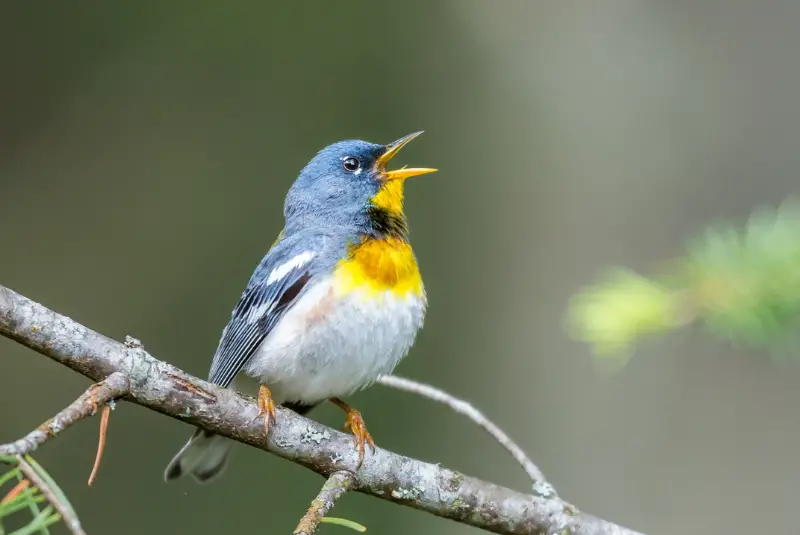
The Northern Parula is a colorful wood warbler that has distinct markings on its body.
The upperparts of adult males are mostly blue, and they have a yellowish green patch on the back, in addition to two white wingbars.
One of the most distinctive features is the bright yellow throat, as well as an orange breast band.
The eye of the Northern Parula has a partial white eyering, which is a great feature for identification of this little warbler.
It is a common summer visitor in North Carolina that can be seen in deciduous and mixed woodland. And although it is a migratory bird, some individuals can be seen year-round in southern North Carolina.
Tree Swallow
Scientific name: Tachycineta bicolor

The Tree Swallow is relatively widespread in North Carolina, and is most often found close to lakes, marshes, and ponds.
Adult Tree Swallows are greenish blue on top, and have buff white underparts. Their feathers are iridescent, and change color when viewed in direct sunlight.
While adult females look similar to adult males, young individuals are more grayish brown with a white underside.
This swallow readily accepts suitable nesting boxes, which gives you an opportunity to attract this attractive blue-colored North Carolina bird to your backyard.
It feeds exclusively on insects that it catches in the air, and as a strict insectivore it is a long distance migrant that only spends the summer in North Carolina.
Tree Swallows winter around the Gulf of Mexico, as well as in Central America.
Barn Swallow
Scientific name: Hirundo rustica
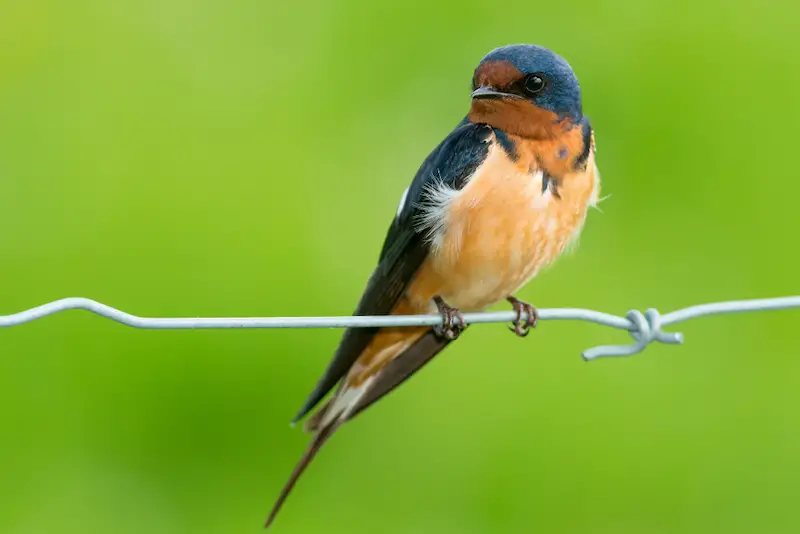
The Barn Swallow inhabits nearly all of North America south of the Arctic circle and may be found in a wide variety of habitats.
It has iridescent blue upperparts that shimmer in various shades of dark blue when the sunlight hits them.
Its underside is reddish-orange, including a chestnut orange forehead and throat, as well as a light reddish-orange belly.
The deeply forked tail of Barn Swallows is another great feature you can use to identify this blue bird.
However, keep in mind that immature barn swallows have a duller plumage than adults, as well as a shorter tail that is less forked.
The Barn Swallow used to nest in caves and hollow trees, but nowadays it prefers to do so beneath the overhangs of buildings and bridges, as well as inside barns (which explains how it got its name).
These swallows of North Carolina are still a reasonably common sight in most areas. However, the overall numbers of Barn Swallows have been steadily decreasing, especially in the northern section of their range.
This decline is likely a result of the loss of foraging areas and nesting opportunities.
The Barn Swallow feeds on flying insects, such as mosquitoes and flies, and catches them closer to the ground than other species of swallows. In its winter quarters it also feeds on termites.
It is a strictly migratory bird, and spends the winter in Central and Southern America.
White-eyed Vireo
Scientific name: Vireo griseus
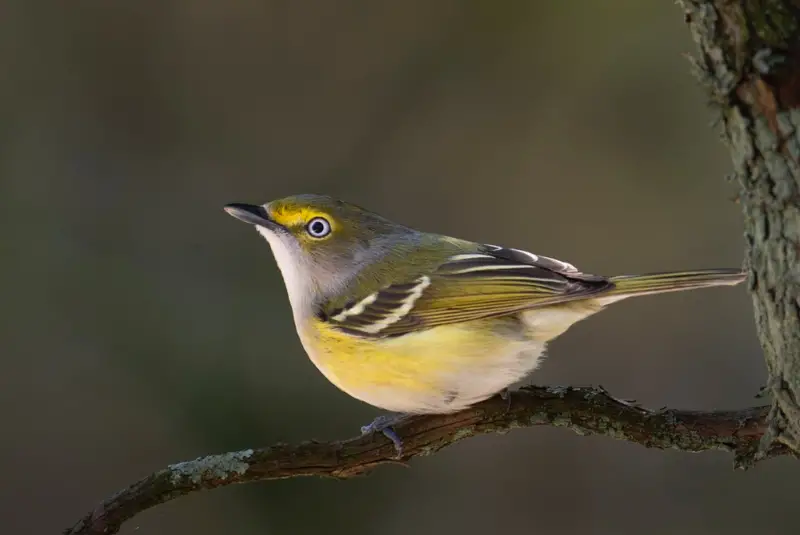
The White-eyed Vireo is a relatively drab bird with a mix of grayish brown and pale greenish colors.
A great feature to identify it by is its pale iris, which distinguishes it from other similar looking birds.
The underparts are buff white, and there are two distinctive white wing bars. The White-eyed Vireo is a year-round resident in North Carolina.
It breeds in deciduous forests, and feeds on insects and other small invertebrates.
Black-and-white Warbler
Scientific name: Mniotilta varia
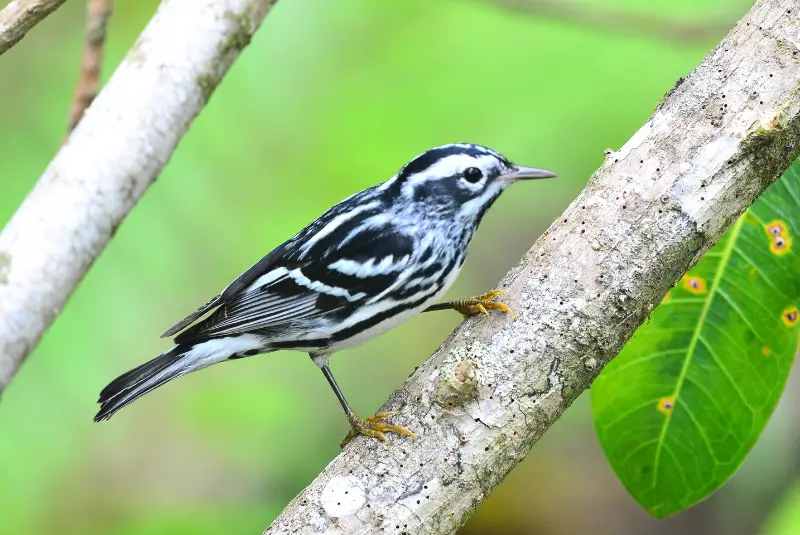
The Black-and-white Warbler has black upperparts with white stripes, as well as black wings with white wing bars. When the wings are folded, the stripes look more like white spots.
Unlike many other warblers, female Black-and-white Warblers look very similar to the males, except for lacking the black stripe behind and below their eye, which increases the white area on their black head.
The Black-and-white Warbler breeds in the eastern parts of North America, where it can be found from May to August from Canada in the north to North Carolina in the south.
It is a seasonal migrant that spends the winter in Central America, with a small percentage of its population wintering in North Carolina and the Gulf Coast.
It can be found in a range of diverse forest habitats, and feeds on insects and other invertebrates.
Yellow-throated Warbler
Scientific name: Setophaga dominica

The Yellow-throated Warbler is easily identifiable by its vibrant yellow throat, which contrasts with black-and-white head markings and a blueish gray back.
While Yellow-throated Warblers rarely visit feeders, you can still attract them to your backyard by planting native shrubs and trees that provide a suitable foraging habitat for these birds.
Yellow-throated Warblers are year-round residents in North Carolina, where they nest in deciduous woodlands. But they can be hard to observe, since they mostly forage in treetops.
Cerulean Warbler
Scientific name: Setophaga cerulea
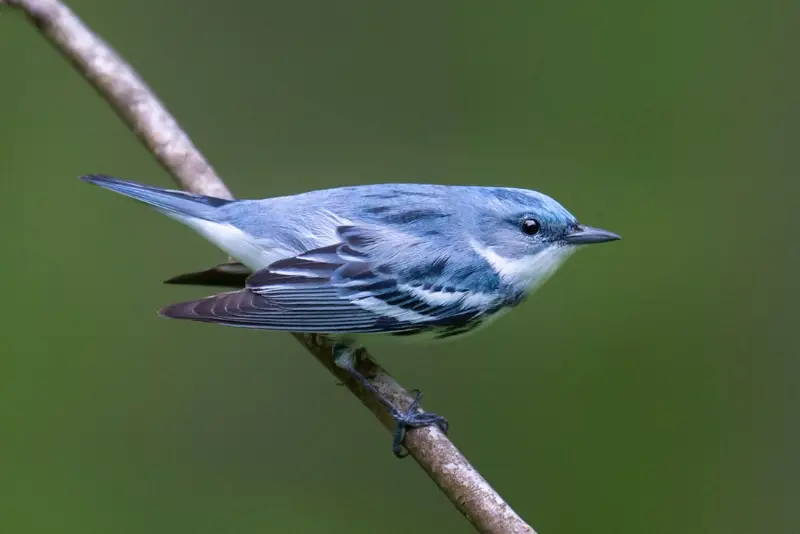
The Cerulean Warbler is a gorgeous songbird, but its population has steadily declined over the decades, and it is now classified as endangered.
The upperparts of adult males are baby blue, and their underparts are largely white.
The flanks are marked with a number of black streaks, and the wings have two white wing bars on the secondaries.
In contrast to the male, the blue portions of an adult female’s plumage are replaced with a greenish hue, although the sexes otherwise look similar.
The Cerulean Warbler is a visitor in North Carolina during migration, as it migrates to South America to spend the winter.
The numbers of this blue and white-colored warbler have been declining steadily due to loss of habitat, and so it is in need of strict conservation efforts.
Ruby-crowned Kinglet
Scientific name: Regulus calendula
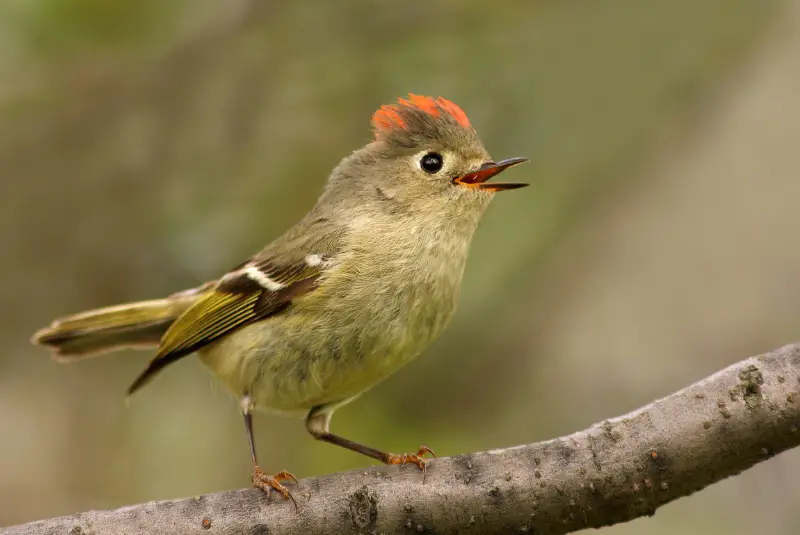
The Ruby-crowned Kinglet is a tiny bird that is best identified by its ruby-red crown on its head, although this is only present in adult males.
Females and juveniles look similar to males, but lack the red crown patch. They are regular winter birds in North Carolina, where they can be found in a range of woodland habitats.
Kinglets are “hyperactive” birds that are always on the go, looking out for insects in the leaves of shrubs and trees.
Downy Woodpecker
Scientific name: Picoides pubescens

The Downy Woodpecker is the smallest woodpecker found in North Carolina.
While males are black and white with a small red patch on their nape, females are entirely black and white.
The wings of both sexes are black with white bars, which look like spots when the wings are folded.
Downy Woodpeckers are non-migratory, and can be seen all year round throughout North America, except for the arid regions in southern states.
You can tell this woodpecker apart from the Hairy Woodpecker by its smaller size and short bill.
While Downy Woodpeckers don’t migrate, they like to move around outside of the breeding season, in search of areas with plentiful food.
Their preferred habitat is deciduous or mixed forest, where they feed on insects and insect larvae found under the bark of trees. During winter they also eat berries and seeds.
Eastern Towhee
Scientific name: Pipilo erythrophthalmus
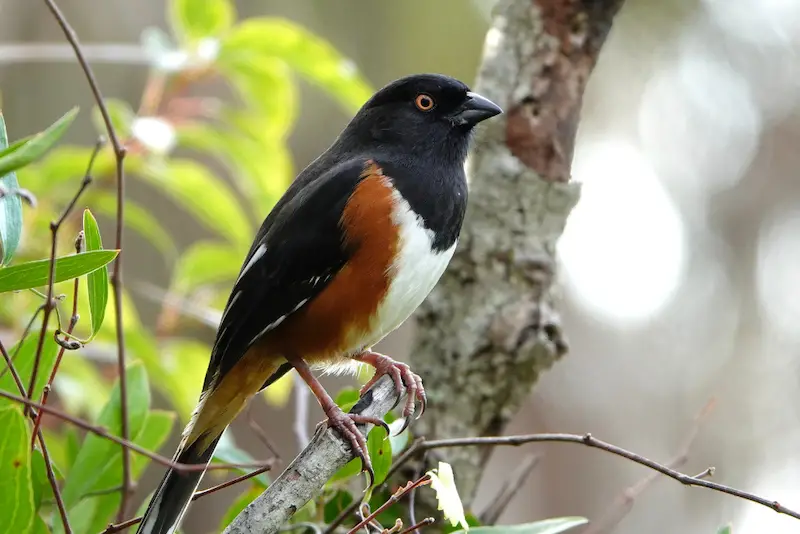
Towhees got their name from the characteristic “Tow-hee” cry that both genders use.
While Towhees don’t belong to the blackbird family, male Eastern Towhees are largely black, with rusty-brown sides and a white underside.
However, its back and head are completely black, and depending on your viewing angle, it can look entirely black.
When the Eastern Towhee takes to the air, white comma-shaped wing patches become visible on the upper side of its wings.
North Carolina is home to the red-eyed form of this species, which can be found year-round in the Old North state.
Although the female incubates the eggs until they hatch, the male does the heavy lifting when it comes to feeding the young.
The Eastern Towhee, similar to all other species of towhee, forages by making a comical backwards hopping motion with both feet at the same time.
It does this in order to displace leaves and expose the seeds and insects that are concealed under them.
You can readily attract these little birds to your feeder with black oil sunflower seeds.
Carolina Chickadee
Scientific name: Poecile carolinensis
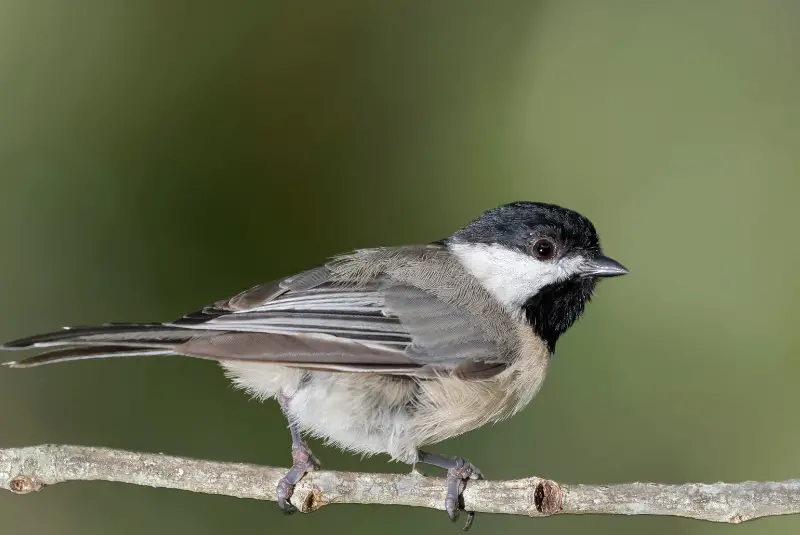
The Carolina Chickadee is easily identifiable by its black cap and black throat. Both sexes look similar and have a grayish back and buff white underparts.
The black markings on the head contrast with the bright white cheeks. It is a year-round resident in North Carolina, and nests in deciduous forests.
The Carolina Chickadee readily visits backyard feeders, and has a preference for black oil sunflower seeds. It also accepts nest boxes as a substitute for treeholes.
Common Yellowthroat
Scientific name: Geothlypis trichas
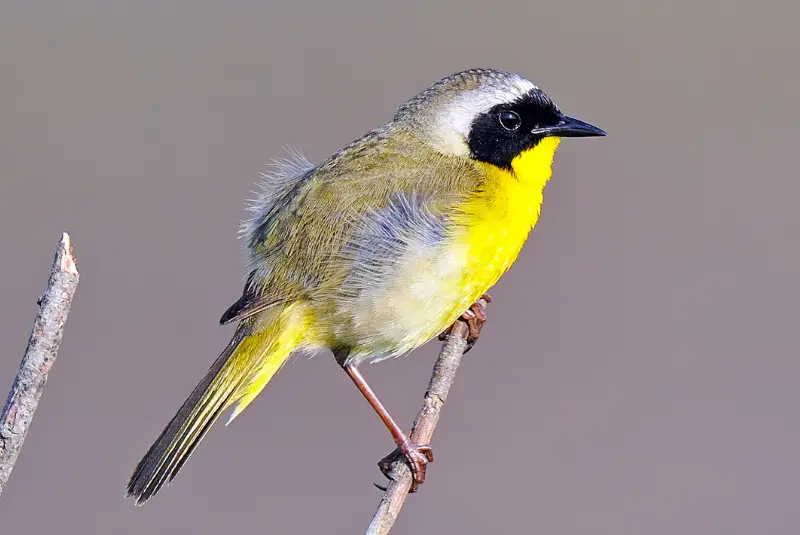
The Common Yellowthroat is a brightly colored small wood warbler. Adult males have a bright yellow throat and chest, as well as a broad black mask that covers the forehead and cheeks.
The black face mask is bordered on top by a grayish white band, which transitions into the olive brown nape and back. Females are similar, but lack the black face mask.
The Common Yellowthroat is a widespread breeding bird in North Carolina, where it is a year-round resident.
However, during winter, its numbers swell due to northern individuals that winter in the Old North state.
It prefers shrubland and grassy habitats, and feeds on insects and other invertebrates.
Summer Tanager
Scientific name: Piranga rubra
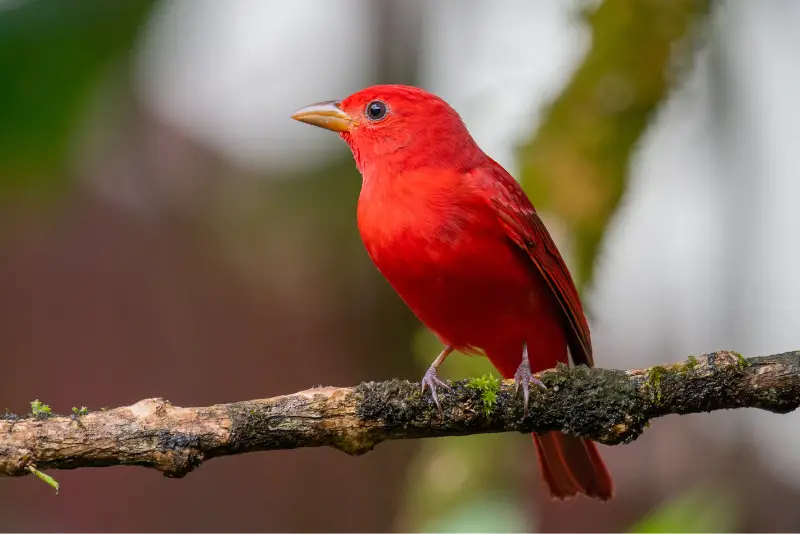
The Summer Tanager is a beautiful and alluring little songbird with a peaked (as opposed to rounded) crown.
Adult male Summer Tanagers are entirely bright red, although they have slightly darker feathers on their wings.
It can be hard to observe Summer Tanagers, since they like to forage high in the treetops of deciduous and mixed forests.
In contrast to males, females and immatures are buff yellow, although they sometimes have a few patches of pale red.
The Summer Tanager is a summer visitor and breeding species in North Carolina, and can be seen here from May through August.
This small songbird is strictly migratory, and spends the rest of its year in Mexico and Central America.
Eastern Bluebird
Scientific name: Sialia sialis
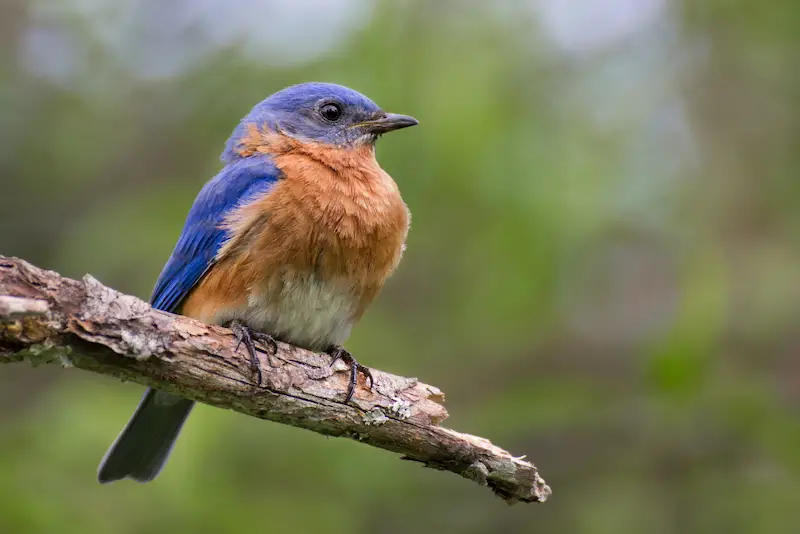
The Eastern Bluebird is a brightly colored and widespread breeding bird in North Carolina.
The upperparts of adult male Eastern Bluebirds are a rich shade of admiral blue. Their blue coloration also extends to their wings, tail, and the back of their heads.
The partial orange collar of males creates the impression of having a cap on their head. Male bluebirds have a prominent orange chest, with shades of warm-toned rufous brown.
The upperparts of adult females have a more grayish-brown color. However, females also have blue tail feathers and wing feathers, as well as a rufous-orange chest and flanks.
It is a migratory bird in the northern part of its range, but can be seen year-round in the southern part of the United States. Northern populations winter in Mexico.
The Eastern Bluebird nests in holes, and competes with House Sparrows and European Starlings for nesting sites.
During their fall migration, they can be seen in flocks that like to feed on fruits and berries.
The population of Eastern Bluebirds underwent a dramatic decline at the end of last century, due to lack of nesting holes and competition with European Starlings.
But largely thanks to the efforts of numerous North Carolina citizens providing nest boxes for Eastern Bluebirds, these beautiful birds are a regular sight once more.
Common Starling
Scientific name: Sturnus vulgaris
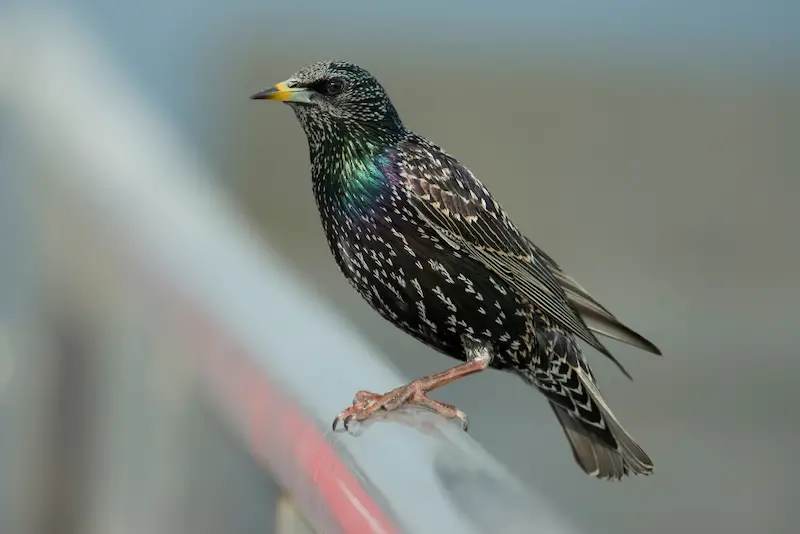
The Common Starling (also known as European Starling) is a widespread backyard bird in North Carolina. Adult birds are uniformly black with a glossy sheen.
During winter, the black feathers of Starlings are covered with light spots, which can be a great characteristic to identify them.
This species is originally from Europe, Asia, and North Africa, but it was introduced to North America and many other parts of the world, where it has established itself as a successful breeding species within a short period of time.
These Starlings inhabit open country with few trees as their original habitat, but they are also among the most successful urban birds, and are especially widespread in parks and gardens.
While these birds nest in tree holes in the wild, they are also known to nest inside buildings and nest boxes in urban settings.
Unfortunately, native birds are sometimes driven out of their nesting sites by competing Starlings.
Similar to grackles and other blackbirds, Common Starlings form large flocks outside of the nesting season.
These flocks can contain more than a million individuals, and can be seen performing amazing aerial acrobatics.
House Finch
Scientific name: Haemorhous mexicanus
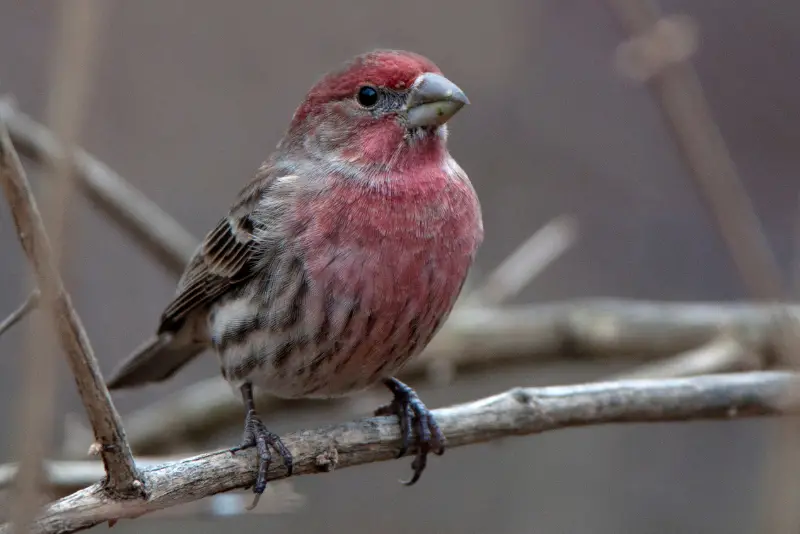
The House Finch is one of the most common small birds in North America, and is mostly found in settled areas, ranging from small towns to large metropolitan centers.
Adult male House Finches can be identified by the bright red feathers on the head and upper breast, although in some cases they are slightly more orange or yellowish in color.
The females lack any red coloration, and instead have grayish streaks on a brown background.
The House Finch was originally a western bird, and it wasn’t until the 1940s that it was discovered in New York and other places on the east coast of the US.
The eastern House Finch population began to grow in the 1950s and 60s, and by the year 2000, it had expanded so far west that it connected with the original western population.
The House Finch is entirely herbivorous, and feeds on seeds, buds, and fruits.
If you set up a bird feeder in your backyard, you can expect House Finches to be among the first birds to visit it.
The House Finch is found in North Carolina all year round, and while it is not a migratory bird, it does move to areas with more food outside of the breeding season.
Red-winged Blackbird
Scientific name: Agelaius phoeniceus

The Red-winged Blackbird is one the most abundant birds in North Carolina, and it is one of the most common black birds found in the Old North state during the summer.
The great thing about these North Carolina blackbirds is that you can easily distinguish males from females.
Male Red-winged Blackbirds are completely black except for the bright red patches on their wings. In contrast, females (and juveniles) are a blackish brown color with white streaks.
Generally speaking, this blackbird lives in open fields and near water. It is often found in marshes, wetlands, and around lakes.
To find food, the Red-winged Blackbird travels many miles a day, especially outside of the nesting season.
While this blackbird is primarily a seed-eater during fall and spring, it switches to feeding almost exclusively on insects during summer.
Depending on where it is found, the Red-winged Blackbird is either a seasonal migrant (in the north of its range), or a resident (in the south of its range).
Red-winged Blackbirds roost in flocks up to millions of individuals strong, creating a deafening noise with their rapidly beating wings.
In spring, males are usually the first ones to arrive in order to claim a desirable territory before the females arrive.
During the mating season, the male will sing from a conspicuous perch and display the red shoulder patches on his feathers in order to attract the attention of females.
After a female chooses a mate, she builds her nest over shallow water in a thick stand of vegetation. Her chosen mate then aggressively defends the nest against other blackbirds.
The most successful males are bigamous, and can mate with multiple females at the same time.
Indigo Bunting
Scientific name: Passerina cyanea
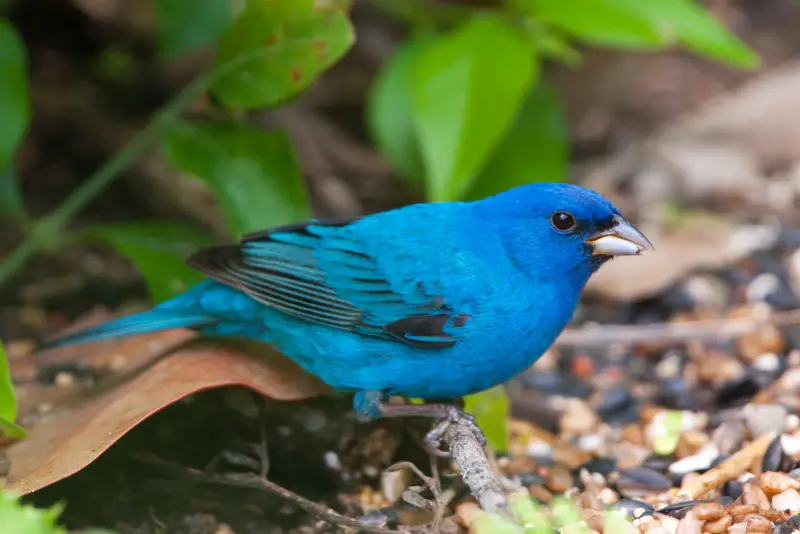
The Indigo Bunting is a brightly colored small finch. During the summer, the male is almost entirely indigo blue, except for darker brownish wingtips and tail feathers.
Females and juvenile birds are more inconspicuous, with light brown upperparts, and creamy white underparts.
The Indigo Bunting is a relatively widespread bird in North Carolina found at forest edges, weedy gardens and parks, and will readily visit bird feeders that offer seeds.
This blue bird is most often seen at bird feeders in spring, as it switches over from seeds to eating mostly insects during the summer.
During the breeding season, males can often be observed singing from a treetop perch.
This blue bird is a strict migratory bird, and is only found in North Carolina during the summer. It winters in Central and South America, and migrates in small flocks during the fall migration.
Northern Cardinal
Scientific name: Cardinalis cardinalis
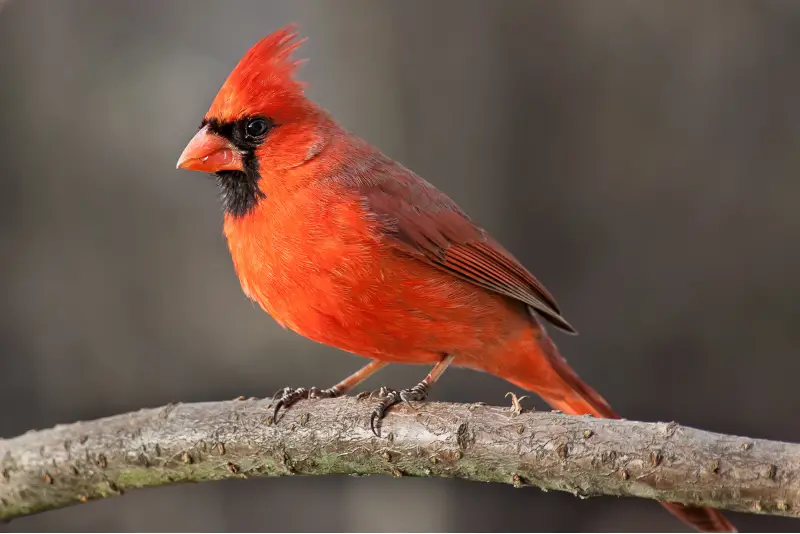
As the state bird of the Old North State, the Northern Cardinal is one of the most familiar red birds in North Carolina.
Male Northern Cardinals have a bright crimson red coloration on their head, chest, and belly, and slightly darker red on their back and wing feathers.
In addition, the face has a black mask extending from the bright red bill to the throat.
Female Northern Cardinals are not quite as colorful as males, and have a more buff-brown body color with some reddish tinges, although they also have a bright red bill.
The Northern Cardinal is a common backyard bird in North Carolina, and can be seen year round in backyards, small forests, and parks.
During the winter months it doesn’t defend its territory, and sometimes gathers in flocks of up to 25 individuals that feed together. The Northern Cardinal is a regular visitor at bird feeders.
What are the small brown birds in North Carolina?
The small brown birds that can be regularly seen in North Carolina backyards are wrens, which are tiny birds with a loud voice.
During the summer months, the most common wren species in North Carolina is the Carolina Wren, while in winter it is joined by House Wrens that winter in the state.
In addition to wrens, female House Finches are small birds that are brownish gray, and are often found in backyard gardens all over the Old North state.
If you enjoyed this article, check out our guide to the large birds of North Carolina.

